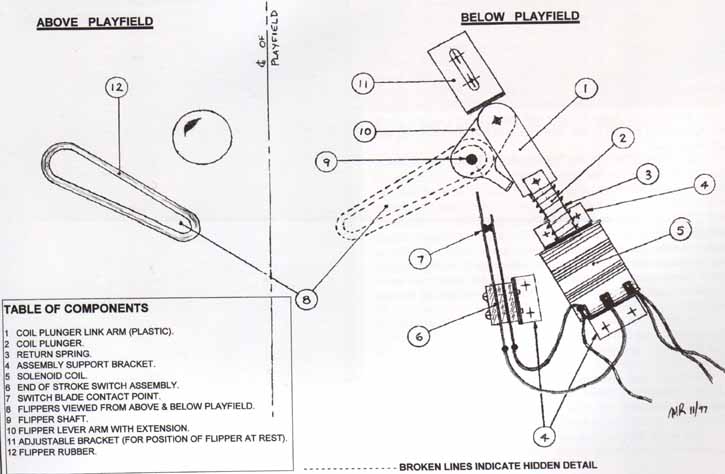Flippers are the players main tool in controlling the action of the pinball. There are usually two of these although three or four are found on some games. The player controls the flippers with the flipper buttons on each side of the cabinet. The buttons on each side control the flippers on their respective sides. The flippers in like-new condition can be made even stronger with some simple modifications.

The physics:
The player pushes in on a flipper button which causes the flipper switch to close, completing a circuit to the flipper coil.
The energized coil magnetizes the iron core which is pulled in and attracted to the coil stop at the end of the coil. A link connects the core to an arm that physically connects to the flipper.
The flipper "bat" is attached to a shaft which in turn connects to an arm under the playfield. The link on the iron core pulls on the arm and this combination is rotated about the shaft (levers, torque) and the flipper swings forward on the playfield, either to hit a ball or to hold a ball in place.
The flipper solenoid is a double wound coil. The "pull-in" winding is a strong winding, constructed of heavy guage wire, to insure a fast pull in of the iron core. The "hold-in" winding is a weaker winding, constructed of a lighter guage wire. When the iron core is pulled in, a solenoid end-of-stroke switch (EOS switch) is opened to cause the circuit to go through both windings, thus preventing a solenoid burnout when the flipper button is held in (for example when the player chooses to "hold" the ball. A small arm on the flipper assembly swings around to open this switch.
The force of the flipper bat for a moment of time (impulse) produces a change in momentum of the ball (direction change as well as speed increase) to hit it back up the playfield.
Upon release of the flipper button the flipper switch opens, deactivating the flipper solenoid.
The spring force returns the iron core to its original position.